The Kitchen as a Laboratory: Get Ready for the Next Experiment
Yasuko Furuichi
(Asia and Oceania Section, Arts and Culture Dept.)
On Saturday mornings, I routinely watch a certain popular TV program with the commercial break, during which a Tokyo Gas advertisement is shown. It is about a group of young men chatting while deftly preparing various dishes to have the meal for themselves. This ad has a young female group version to follow. I don't know why the male and female versions feature western food and Japanese food respectively. Nevertheless, the catchword of the ad is quite inspiring: "Chatting is a great meal." It was only natural for me to accept this concept and I found it somewhat reminiscent of the process of Media/Art Kitchen, the project implemented by the Japan Foundation in four Southeast Asian countries.
Chatting is communication. Were we able to enjoy the project as much as we thought of it as a great meal? What taste of food (results) did we manage to prepare in our kitchen? How did people like the taste?
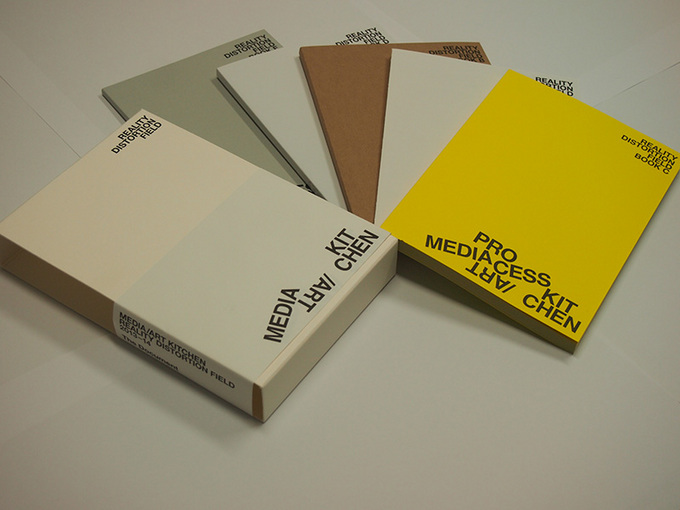
Media/Art Kitchen compiled into a set of books
Media/Art Kitchen was implemented in the four Southeast Asian cities of Jakarta, Kuala Lumpur, Manila, and Bangkok to commemorate the 40th Year of ASEAN-Japan Friendship and Cooperation in 2013. Through this project, young curators and artists from Japan and Southeast Asia collaborated on the common theme: media art. The 13 curators (four men and nine women) who participated in the project challenged two tasks: "What is Media/Art?" (philosophical) and "Collaboration" (practical). A cumulative total of 100 artists were involved in the initiative. Media/Art Kitchen held in the four cities became a unique project with diversity appropriate for the contemporary art scene of each country. As for the details of the project, the curators have already reported with their feedbacks, so I don't need to touch upon it here.
I believe that this project successfully reaffirmed the contemporary significance of the spiritual, sensory, and scientific nature of media art from both the perspective of the artistic expression using cutting-edge technology and the standpoint of the expression seemingly primitive and naturally occurring. The intellectual excitement and playful spirit presented by media art had an impact on the audience that had been unfamiliar with art. They found their own way to accept it and changed it to something familiar to themselves. Also, the expression method deeply connected with the physical senses including vision proved the potential of media art to expand the domain of art per se. Moreover, the audience made a new discovery and found pleasure in the new works which realized a reinterpretation of the spirituality shown in Southeast Asia's unique culture
The curators involved in the project met for the first time in the summer of 2012 in Tokyo. Since then, they were always on the move, brainstormed ideas, shared information and visions, and met in a different capital every month to work on the contents of the project which differed from one country to another. They had to reconfirm the importance of communication on many occasions. This was the same with the artists. They rushed around the Southeast Asian countries to complete their artwork, and hold workshops and labs. In that process, the participants sometimes confronted with the situations they could not handle or solve on their own. For instance, in the Philippines, they experienced the disaster caused by a typhoon which hit the southern part of the country around the same period of time when the project took place, and in Thailand, it became extremely difficult to keep holding the exhibition due to the political instability. Under such circumstances, each curator was severely tested for his/her capability to handle unexpected events on site. Coordination and collaboration among relevant institutions and involved parties in each country are indispensable for this kind of experimental project conducted in various environments. I tip my hat to the personnel in charge at the Japan Foundation overseas offices for their patience and commitment. I would like to express our deepest gratitude to everyone who cooperated and assisted in the implementation of the project. I hope that all involved in this project had a lot of fun.
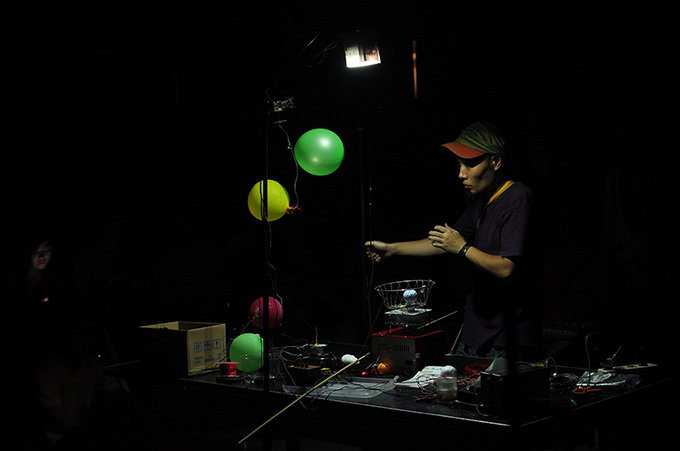
Opening performance by Kanta Horio (Jakarta Exhibition)
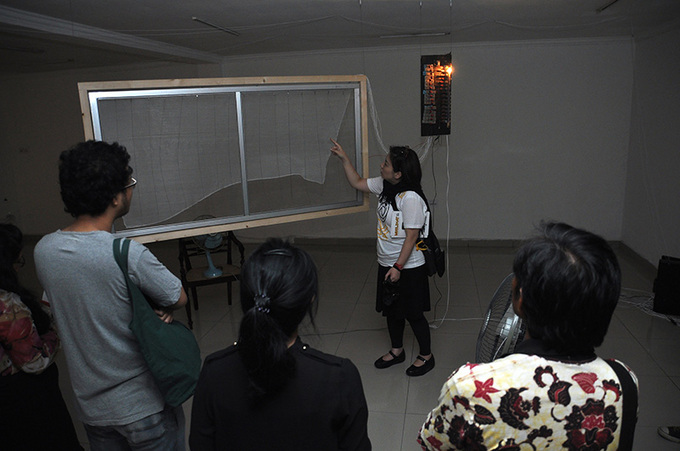
Guided tour by curator (Jakarta Exhibition)
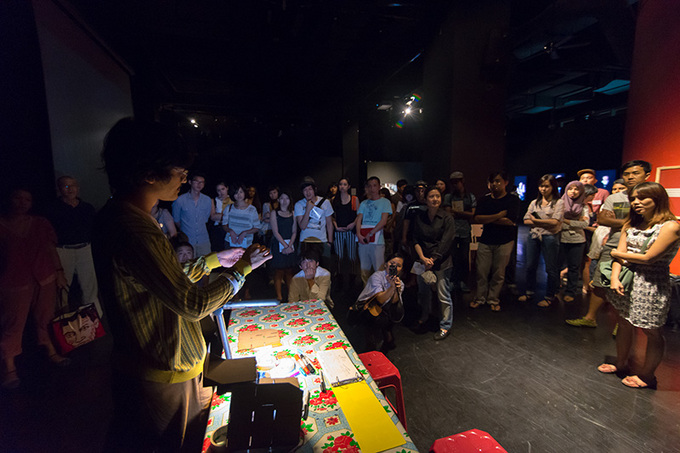
Fairuz Sulaiman talking about his work at the opening (Kuala Lumpur Exhibition)
Photo: Ch'ng Shi P'ng
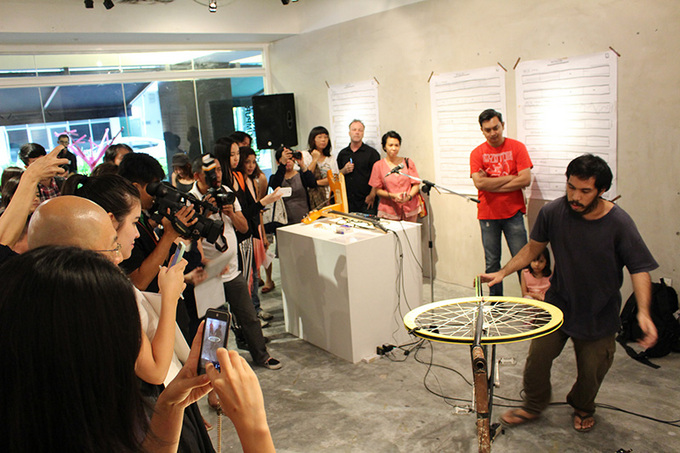
Bani Haykal talking about his work at the opening (Kuala Lumpur Exhibition)
The first collaborative project initiated by the Japan Foundation through joint planning in the field of Asian art was "Under Construction" which was launched in the early 2000s. In August, 2000, nine young curators from seven Asian countries gathered in the Tokyo office of the Japan Foundation and commenced the project. The shared theme was "What is Asia?", in other words, what is the contemporary significance of the concept of Asia. The curators were given the task to cooperate based on this theme. Emerging curators in their twenties and thirties who hadn't even got out of their countries faced such an extremely big theme that researchers might be able to handle. But they started to challenge it. They delivered discussions and conducted field research, and then discussions again. The curators held seven local exhibitions in their home countries. Finally, they organized the comprehensive exhibition in Tokyo. "Under Construction" had developed into a three-year project conducted by trial and error before we knew. The curators and I learned a lot from this first-time experience and the project became the basis for our future initiatives. Today, in more than 10 years after the completion of the project, the then-young curators play a major role in different Asian countries.
By the way, let me get back to the Media/Art Kitchen project. The kitchen was a laboratory. Was the Under Construction project of the 2010's successful? The curators, artists, and the staff members of the organizations that supported the project can say to each other now, "You did a good job!", which I believe means that all of the participants shared "the same feeling" about the project while being aware of both successes and improvements. In my opinion, this sense of solidarity is the greatest accomplishment (reward) of the Media/Art Kitchen project. Furthermore, if we work together again someday in 10 or 20 years, it will imply that we who live in Asia share the same field and embark on the common "era". Just like the Under Construction generation of ten years ago experienced, we see the Media/Art Kitchen project still ongoing. I keep my fingers crossed for the Media/Art Kitchen generation in the field of Asian art which continues to change.
Related Project: Media/Art Kitchen inYamaguchi and Aomori
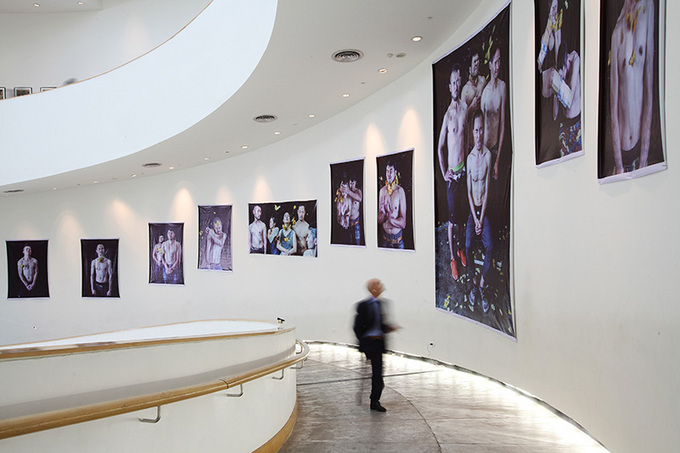
Installation view "Portraits with flying yellow object" by ContactGonzo (Bangkok Exhibition)
Photo: Sittidej Nuhoung

Installation view
(Bangkok Exhibition)
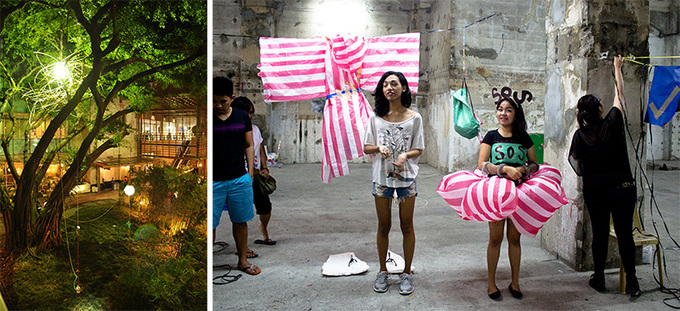
Left: Tetsuya Umeda "Almost Forgot" (Manila Exhibition)
Right: "Re-mediation," the laboratory set up by Stephanie Syjuco and Mark Salvatus
Photo: Martin Vidanes
Yasuko Furuichi
Exhibition Coordinator at the Asia and Oceania Section of the Arts and Culture Department, the Japan Foundation
Since 1990, Ms. Furuichi has been involved in numerous art exchange projects between Japan and other Asian countries implemented by the Japan Foundation. In addition to her efforts to introduce Asian art in Japan and promote Japanese art in Asia, she has participated in collaborative projects with Asian curators and contributed to information exchange and development of networks in the Asian region, adopting a pioneering approach in her work. The recent exhibition projects on which Ms. Furuichi worked include "Re: Quest - Japanese Contemporary Art since the 1970s" (2013 in Korea), and "Media/Art Kitchen" (2013-14). She is also an exhibition coordinator for the Asia Center, which was newly-established at the Japan Foundation in April 2014.
Keywords
- Media
- Arts/Contemporary Arts
- International Exhibition
- Japan
- Indonesia
- Thailand
- Philippines
- Malaysia
- Media/Art Kitchen
- ASEAN
- media art
- South East Asia
- Jakarta
- Kuala Lumpur
- Manila
- Bangkok
- Tokyo
- curator
- Kanta Horio
- Fairuz Sulaiman
- Bani Haykal
- Yamaguchi Center for Arts and Media
- YCAM
- Aomori Contemporary Art Center
- ACAC
- Under Construction
Back Issues
- 2024.3. 4 Movie Theaters aroun…
- 2023.4.10 The 49th Japan Found…
- 2023.3.28 JF's Initiatives for…
- 2023.1.27 Living Together with…
- 2022.11.16 Inner Diversity <…
- 2022.6.21 The 48th Japan Found…
- 2022.3.22 JF's Initiatives for…
- 2022.3.14 JF's Initiatives for…
- 2022.2.14 JF's Initiatives for…
- 2022.2. 4 JF's Initiatives for…

